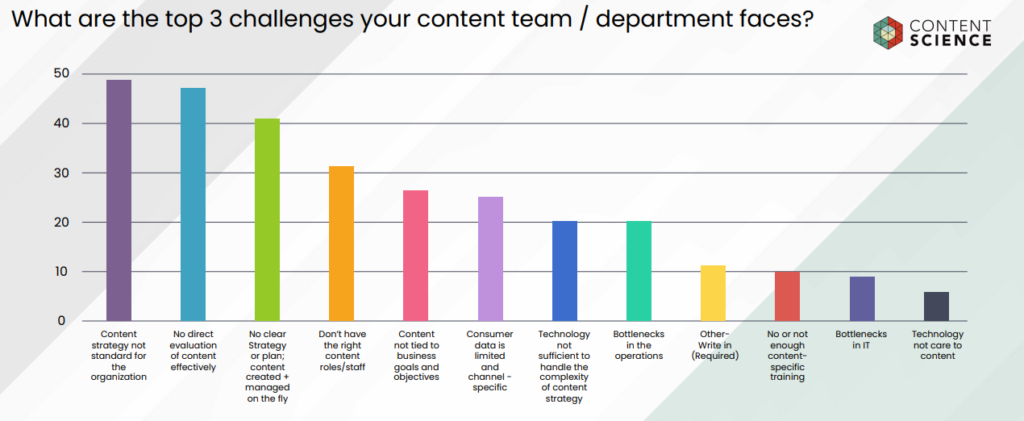
Two steps forward. Three steps back? As a longtime advocate for content, I’m pained to say that appears to be the state of content operations today. Despite our knowing more about what makes content operations successful than ever before, Content Science’s latest research indicates that:
- More organizations are in very early stages of content operations maturity, and fewer are in middle or late stages compared to 2021.
- While more organizations report having a content-focused leader, we have not seen an increase in reports of a content-focused executive.
- Most organizations still view their top content challenges as
- Lack of content strategy (either entirely or lack of alignment across the organization).
- Lack of evaluating content effectiveness or lack of data about it.
- Lack of modern content roles and content technology.

What is going on? Let’s take a closer look at why so many organizations are not more mature and what that means for resiliency in content operations.
Why Are So Many Organizations Struggling with Content Operations Maturity?
My hypothesis is every organization is having to navigate our time of disruptive extremes, which has consequences for content operations. In our 2021 content operations research, we noted that the pandemic had hit like a magnitude 10 earthquake. Our ways of working, living, and playing shifted hard into digital. Many organizations have had to accelerate their digital transformations–and even transform multiple times. In January 2023, I outlined how more tectonic shifts such as political extremism, economic volatility, competing views of the digital future, increasing regulation, and technology booms like generative AI are driving the best and worst of content times.
These disruptive times have brought content approaches—including goals, strategies, and related operations—built over many years tumbling down. (Cue the Carole King classic “I Feel the Earth Move.”) The approaches were developed for different times and for different assumptions, so they no longer work. For example, when a company has to adjust or completely revamp its business model, its approach to content has to change, too. The frequency of disruption today is outpacing the formation of content operations. The ramifications look a lot like two steps forward, three steps back. This situation might seem to be much bad news, but I actually have good news. For one thing, we know that content professionals and leaders see value in mature content operations. They all aspire to become more mature or successful. For another thing, our research adds to the evidence for what makes content operations work well. We can be even more confident in success factors like communicating a vision, setting a strategy, measuring and evaluating content impact, using a governance approach like a center of content excellence, and more. Just because the walls of our content operations collapse in extreme conditions does not mean everything we do to build them is wrong. Much of it is right. The challenge now is to keep doing what works while making our content operations resilient. Merriam-Webster notes that in physics, resilience is the ability of an elastic material to absorb energy (such as from a hit) and release that energy while springing back to its original form. Our time of content extremes is exciting but also difficult. Every disruption is like a blow to our content approaches. Are we going to absorb and use that energy productively? Or are we going to let it knock us down? This physics origin is a useful visual as we consider American Psychological Association’s thorough definition. Resilience is the process and outcome of successfully adapting to difficult or challenging life experiences, especially through mental, emotional, and behavioral flexibility and adjustment to external and internal demands. It’s not hard to see why our volatile and highly demanding times mean resiliency matters more now than ever for content. And that begs our final question here… I like to take inspiration from innovations that address the increasing volatility in our physical world, such as the rise of earthquakes. One innovation is building to absorb sudden change. Consider seismic isolation, where a building is decoupled from the foundation so it can absorb and redirect energy effectively. Another innovation is improving detection of activity to increase lead time. With improved sensors and measurement, geologists can predict some earthquakes and identify them much sooner, giving communities more time to plan a response. So with these concepts in mind, I offer four recommendations to increase resiliency in content operations. With every digital transformation your company or organization undergoes, you might not know what content approach you’ll need. But you do know you need content. So, rather than lay off or move content leaders around with every change, put a leader focused on content at a level that can lead through change. This is not unlike decoupling a building from the foundation in seismic isolation. You might train a leader you already have or bring in someone new. The key is to have a role to define modern content vision and culture that factor in digital disruption. Rapid digitization is our new normal. I love how Lymari Morales of Johns Hopkins University credits a vision with making her content operations more nimble, not less when the pandemic hit: I came in, listened and learned first, and then worked with my team to co-create a vision and put that vision on paper. We did that in late 2019 to start piloting it in January 2020…and then when the pandemic came, we were already playing from the same playbook to apply those ideas to this information moment. Keeping loads of outdated and unwieldy content around might sound like an obvious bad idea, but it happens. A lot. At one point, for instance, the Intel digital presence had once ballooned to 32,453 before Scott Rosenberg established governance and led a massive audit. While content debt was never good, it’s especially bad in volatile times. It adds time and expense to any significant change you need or want to make to your content approach. And it’s costly to maintain. I like how Chris Hester of UL Systems explains the benefit of getting content debt under control: If you can start managing your content debt — remove content you don’t need anymore, manage the size of your images, start managing your page weight — you can start laying the groundwork for more sustainable content practices. I’ve noted many reasons over the past few years to measure content effectiveness and create a system of content intelligence. Here’s another. Just as in the physical world sensors help detect change early and often, so we can detect changes that affect content through measurement. A few quick examples include But simply detecting change isn’t enough. You have to discuss it, understand it, and decide how to use it. That’s why making regular review of content intelligence part of your process (including a center of content excellence) is so important. If you don’t decide with your data, you might as well not have it.
One of the many down sides to approaching content in a siloed way is that fragmentation often leads to siloed technology. It’s not unusual for a large organization to have three, four, or even five different content management systems (CMS) deployed. When you almost need two hands (or feet) to show how many CMSs your organization uses, chances are you can’t have a nimble content approach. With more CMS options than ever, you likely can find one that works well across your organization and the customer journey. Consolidating CMSs also follows the lead of seismic isolation. Rather than have your CMS approach mapped to the “foundation” of your organizational structure (a different CMS for every unit or function), your CMS approach is independent of that structure. A CMS is likely not all you need. Wonderful tools have emerged to aid with governance, workflow, creation, measurement, and more. Consider what you might want to automate or accelerate, and there likely is a tool that can help. So, the disruptive times in which we work don’t have to prevent maturing content operations and, consequently, content success. Take inspiration from responding to physical disruption and look for ways to make your content operations resilient. It’s not a matter of if your content approach will need to change. It’s when.What Is Resiliency, and Why Does It Matter Now?
What Can Organizations Do to Be More Resilient in Content Operations?

1. Invest in a Content Executive
2. Manage Your Content Debt
3. Establish Content Intelligence
4. Consolidate CMSs + Expand Your Content Tech
Events, Resources, + More
The Ultimate Guide to End-to-End Content
Discover why + how an end-to-end approach is critical in the age of AI with this comprehensive white paper.
The Content Advantage Book
The much-anticipated third edition of the highly rated book by Colleen Jones is available at book retailers worldwide. Learn more!
20 Signs of a Content Problem in a High-Stakes Initiative
Use this white paper to diagnose the problem so you can achieve the right solution faster.
Upskill with Content Science Academy
Training for modern content roles through on-demand certifications + courses or live workshops.






Comments
We invite you to share your perspective in a constructive way. To comment, please sign in or register. Our moderating team will review all comments and may edit them for clarity. Our team also may delete comments that are off-topic or disrespectful. All postings become the property of
Content Science Review.